Characteristics and recommendations for the use of agrofibre
The covering polymer material is used during the entire growing season and even in winter. Often, a combined coating is used, consisting of a polymer of different densities. For each case, a specific type of geotextile is required. Read more about the features of the spunbond operation.
Shelter greenhouses and soil in spring
Immediately after the end of winter, medium density agrofibre is used (42, 50 or 60 g / m2). White polymer is stretched over frames, constructing greenhouses or hotbeds, and the soil is covered with black, thereby accelerating the heating of the top layer of the soil. At the site of the planting holes, small holes are cut to allow the planting material to germinate.
When planting plants in open ground, they are covered with spunbond with a density of 17 or 30 g / sq. m. The material is quite light, and therefore does not interfere with the growth of young seedlings. It is simply put on top of the garden bed, pressing down along the edges with earth or pebbles.
Protection against heat and rotting in summer
Since the light color effectively reflects ultraviolet light, a low density white polymer is used for the summer months. A shelter made of this type of agrofibre creates the necessary shade for crops, is a shelter from the wind, and also reliably protects against flying insects and birds. Black geotextiles are spread over the ground. Thus, the growth of weeds is stopped, and dirt from the soil surface does not get on low-growing fruits.
 For the summer months use a low density white polymer
For the summer months use a low density white polymer
Prolongation of fruiting in autumn
To increase the fruiting period of some vegetable or berry crops, they are covered with white material. Most often, tomatoes, bell peppers, eggplants, zucchini and plants of remontant varieties need additional shelter. At first, agrofibre is removed every morning, but closer to cold snaps, this practice is stopped. As a rule, the shelter remains in the beds until the first frost.
Winter use
Horticultural crops that require mandatory shelter for the winter are saved from severe frosts with a black high-density spunbond. It is quite durable, does not tear under the weight of a snow cap, and is also easy to use. It is easy for them to cover plants in autumn and shoot in spring. For convenience, special polymer frame shelters are also sold.
For effective use of geotextiles, it must always be laid with the rough side out.
Author's advice
Other uses
Agriculture is not the only application for spunbond. The versatility of polymer fiber allows it to be used in various fields:
- road construction;
- construction of various buildings and structures;
- strengthening of pipelines;
- strengthening of slopes, embankments, moving slopes;
- landscape design;
- landscaping of artificial reservoirs;
- furniture manufacturing;
- textile industry;
- manufacturing of medical materials.
 Non-woven fabric applications
Non-woven fabric applications
Criterias of choice
When choosing agrofibre, it is very important to pay attention to the purpose and characteristics of this material. The selection criteria are quite obvious here, but there are also factors that require special attention. To avoid mistakes, it is worth considering some points from the very beginning:
To avoid mistakes, it is worth considering some points from the very beginning:
- For a greenhouse, it is worth considering exclusively light - translucent, varieties of cover with a density of 30 to 60 g / m2. The material will provide light transmission at the level of 85-65%, cut off harmful ultraviolet rays.It is possible to equip a greenhouse with such a coating already in March, the soil will warm up better, and residual frost will not damage the seedlings.
- Shrubs and trees need to be insulated with the thickest agrofibre. In regions where the winter temperature drops below -20 degrees, it is recommended to use the material, folding it in 2-3 layers to avoid frostbite on the branches.
- The thickness of the agrofiber affects its light transmission. Experienced gardeners change the surface throughout the season. In early spring, the thinnest canvases are used to help the seedlings warm up faster and grow. During the period of fruit ripening, you can choose a coating with indicators of about 30-40 g / m2.
- Agrofibre with colored coating - yellow, pink, purple - works to increase yields. It serves as a kind of filter in the path of sunlight, protecting plants from external factors that are dangerous to them. The average increase in the number of fruits can reach 10-15%.
- For growing strawberries, choose a black or black and white cover. It helps to make plant care, harvesting as simple and convenient as possible. The absence of weeds in the beds makes it possible to direct all nutrients to the development of cultural plantings. Such a coating will help to minimize the care of other plants - cabbage, tomatoes, cucumbers in the open field.
Considering these selection criteria, you can easily find the right agrofiber for use in the country, in the garden or in the greenhouse.
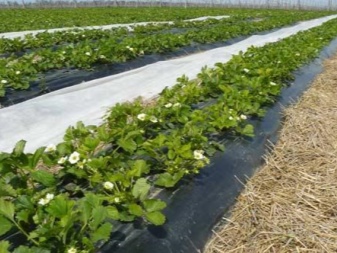
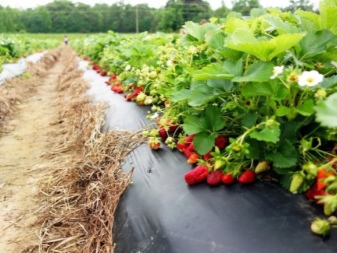
You can find out how to make a greenhouse on a site with your own hands using agrofiber by watching the following video.
What categories of spunbond nonwoven fabric are suitable for construction
In the construction industry, agrofiber is used as an insulating material. Thinner spunbond is used by analogy with mesh during rough finishing. Depending on the density, the canvas is classified into three categories.
 Due to its characteristics, nonwoven material is widely used in the construction industry.
Due to its characteristics, nonwoven material is widely used in the construction industry.
Roof and facade windproofing
The density of agrofibre 50-100 g / m² belongs to category A, such a canvas is used to protect structures from wind, moisture and internal condensation.
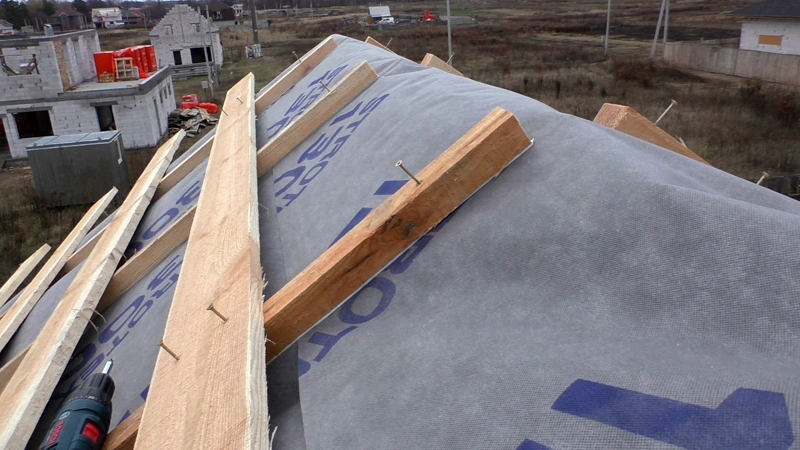 For protection from wind, it is necessary to use a covering material of increased density.
For protection from wind, it is necessary to use a covering material of increased density.
Vapor barrier of structures
Category B includes textiles with a density of 40-60 g / m². In the construction industry, it is intended for the internal protection of insulation and structures from vaporization that can arise from inside the house.
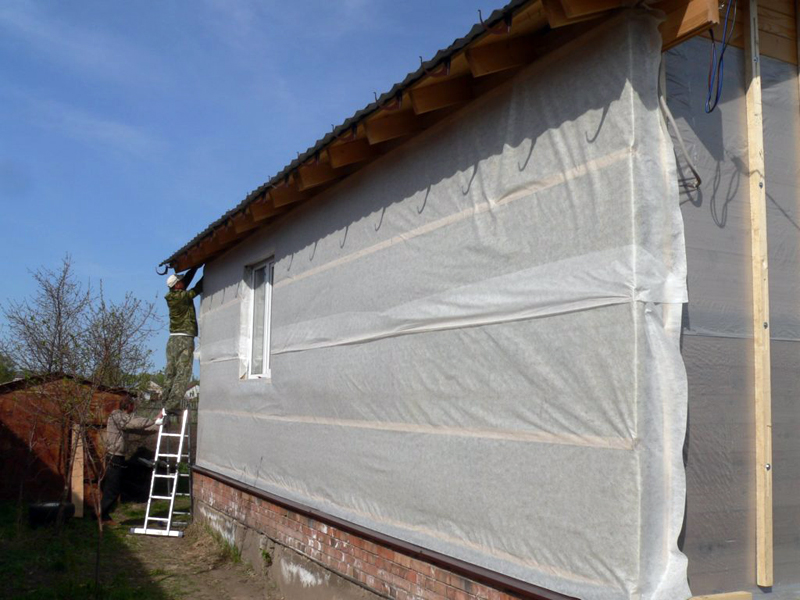 For protection, you can use laminated spunbond, the surface of which is treated with antioxidant compounds
For protection, you can use laminated spunbond, the surface of which is treated with antioxidant compounds
Waterproofing membranes in construction
Laminated cloth with a density of 70-90 g / m² belongs to category C and reliably protects building structures from external influences. It is used as waterproofing against moisture in places where roofing material does not fit tightly, as well as in interfloor ceilings, basements and attic rooms.
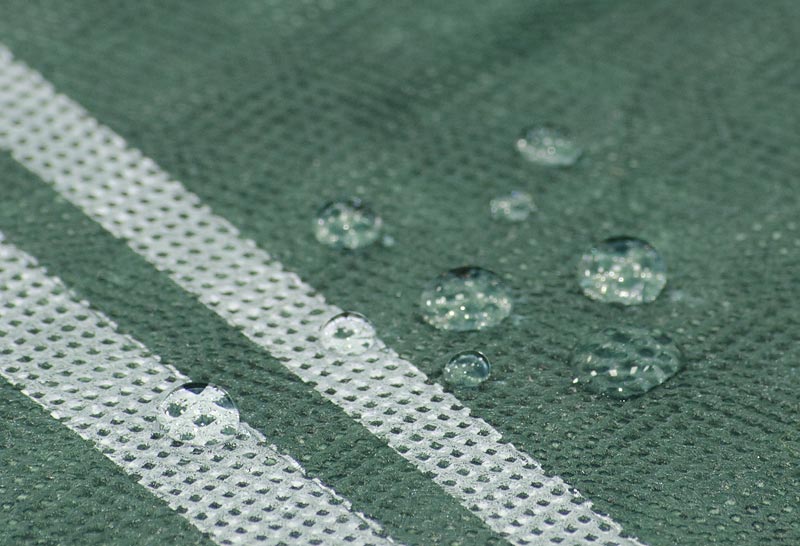 Waterproofing layer protects structures from moisture
Waterproofing layer protects structures from moisture
Application of white spunbond
White spunbond of varying density is most often used instead of plastic wrap. Plants are covered with it (both in open ground and in a greenhouse), and greenhouses are also built with it. But at the same time, the highest density agrofibre is used, since a thin material can easily damage gusty winds.
As a covering material, spunbond can be found in the garden and vegetable garden all year round. In winter, it protects crops from frost, and in warmer seasons, from the scorching sun, wind and hail. In good weather, the agrofibre is removed, and during a cold snap, the plants are again covered with it.
White spunbond with a density of 17, 19 and 23 g / m2 is most often covered with beds with crops or planted seedlings. Such material is more suitable for light-loving plants. The fact is that agrofibre, 1 sq.m.which weighs 17 g, transmits about 80% of the light, while the densest (60 g / m2) - only about 65%.
Another plus of a thin spunbond is lightness. Even the most fragile plants, as they grow, are able to lift this almost weightless material.
Such agrofibre is used in the cultivation of strawberries, beans, tomatoes, cucumbers, zucchini, peppers, eggplants, all types of cabbage, corn, melons, watermelons, green crops
However, thin agrofibre also has disadvantages: the main one is low frost protection. So, spunbond with a density of 17 g / m2 will protect plants from frosts down to –3 ° С. Material with a density of 19 g / m2. withstands frosts down to –4 ° С, and with a density of 23 g / m2 - up to –5 ° С.
White spunbond with a density of 30 and 42 g / m2 is used for direct laying on beds and for creating tunnel greenhouses. For arcs with a height of 30-35 cm, agrofiber with a density of 30 g / m2 is suitable, and for higher tunnels it is better to use a material with a density of 42 g / m2.
These covering materials can withstand frost down to –6 ° С, perfectly protect plants from wind, hail and even snow. They are more durable than thin spunbond, but they transmit light a little worse, so they are better suited for shade-tolerant crops and plants that are afraid of drafts and break easily under strong gusts of wind.
Very often, this type of spunbond is used to cover tomatoes and cucumbers growing under arches.
White spunbond in 50 and 60 gsm is ideal for windy areas. This dense material can withstand frosts down to -10 ° C, it is used for covering greenhouses and warming perennial crops, trees and shrubs for the winter.
Dense spunbond perfectly protects heat-loving plants in a snowless winter
If you purchase thinner material than necessary, do not be discouraged. Plants can be covered with several layers of spunbond - and they will be reliably protected from adverse conditions.
Examples of using
The field of application of geotextiles is wide, the following types are divided according to their intended purpose:
- Furniture. Not too dense material that is used for upholstered furniture mattress upholstery. Placed under the upholstery fabric, used to protect against dust during transportation.
-
Drainage. It passes water well, due to its special structure it is not clogged with sand, silt, and retains a high filtering capacity for a long time.
- Garden or agrofiber. The main difference is that it is light-stable, that is, it does not react to ultraviolet light.
- Packaging. A thin material from which covers are sewn for packaging (for example, for shoes).
- Building. There are many different materials in this group with different characteristics. The main ones are tensile strength and tensile strength.
Construction
One of the main functions of geotextiles is to separate different layers. These can be different factions, different materials.
When constructing a foundation of any type, a gravel-sand cushion is laid on the bottom of the pit. So that gravel and sand do not mix and perform their functions, geotextiles are laid between them. Its density is 160-180 g / m², but it can be more / less depending on specific conditions.
At the bottom of the pit, when constructing roads, droshky, platforms for cars, playgrounds, lawns, rubble is laid. So that it does not mix with the soil, geotextiles are also placed under the rubble. The density is selected depending on the purpose of the object and the planned load
You also need to look at how important water drainage is.
Drainage pipes are installed in the areas to drain water. They have small holes through which water seeps in, then enters the wells
To prevent the holes in the pipes from clogging, they are wrapped with geotextile membranes. For better filtration, the drainage pipes can be sprinkled with gravel. So that it does not mix with the soil, geotextiles are also used.
For all types of work, so that the materials do not "creep" and do not mix, it is necessary to take the width of the geotextile so that it rises to the entire thickness of the layer of bulk material and is still wrapped by 30-60 cm. doing more will be more reliable. This applies to both construction work and landscaping, gardening, etc.
In the arrangement of the site
Work on the site involves a large amount of land work. For the results to please for a long time, geotextiles are used.
- When forming flower beds and beds, fertile soil is often imported. So that it does not mix with the "native" soil, the layers are separated with this material. Also, it will prevent the germination of plant roots from below.
- When forming hills, hills, to keep the shape, layers of soil are laid with geotextiles.
-
When creating artificial reservoirs, geotextile is placed on the bottom. It is more durable, it will be better to reinforce the foundation pit.
- Separation of different materials when creating rockeries, rock gardens, etc.
- The gaps between the beds can be covered with geosynthetics by sprinkling gravel on top. So the view is solid, and clean, and the weeds do not germinate. When redeveloping, the geotextile is lifted, stones are removed. You can start further work.
- For shelter from the sun, protection from frost, instead of mulch, agrotextile is laid on flower beds and beds, which is the least dense geotextile.
This is only a part of the processes in which this material can be used. There is also a rare use in our country - when creating green roofs.
Positive properties of "Spunbond"
To increase the productivity of garden plants, you can use a special covering material "Spunbond". It is quite popular in our country. The wide distribution of the material is facilitated by its positive characteristics. Here are the main ones:
Recent Entries
Chainsaw or electric saw - what to choose for the garden? 4 mistakes when growing tomatoes in pots that almost all housewives make Secrets of growing seedlings from the Japanese, who are very sensitive to the earth
- Good light transmittance with sufficient shading. This feature allows you to protect the young shoots of your vegetables and herbs from sunburn. At the same time, a sufficient amount of ultraviolet radiation penetrates under the shelter;
- Covering material "Spunbond" creates an optimal microclimate for plant growth in the greenhouse. This is possible due to the required level of air and water permeability;
- The beds covered with Spunbond can be watered without opening. In this case, the material will not get wet and increase its weight. This effect is caused by the property of "Spunbond" not to absorb water, it freely passes through it;
- "Spunbond" has low thermal conductivity, which means it retains heat well. This feature allows you to protect plants from sudden changes in temperature, which are often found in the spring and autumn;
- Plants in the garden can be fertilized and fed with any substance. "Spunbond" is resistant to various aggressive, including acidic and alkaline, media;
- It has great tensile strength. In addition, Spunbond quickly regains its shape after mechanical stress;
- It is environmentally friendly;
- "Spunbond" does not lose its qualities in the temperature range from -55 to +90.
Besides all this, "Spunbond" is unpretentious and does not require special care. Due to its strength, it is able to serve you for 2-3 years, while not losing its positive qualities. It is best to store the material in a dry and warm place, out of direct sunlight.
